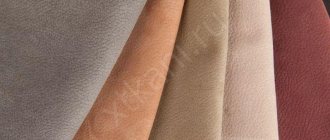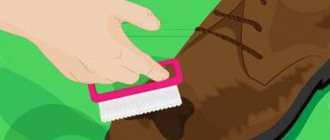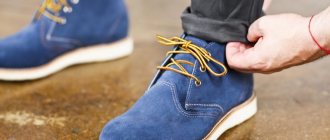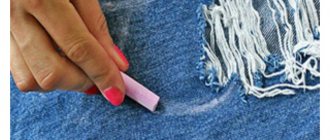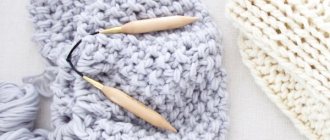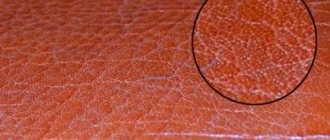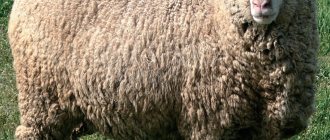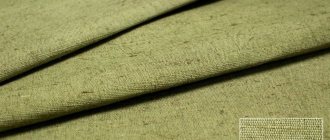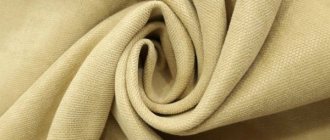11.07.2019
Whatever material the shoes are made of, they need proper care. And if it is suede, then here you should adhere to many rules. These boots, shoes, sneakers and other models look very beautiful. But at the same time, the integrity and appearance of the products can be preserved only with careful care and storage. How to wash suede shoes so that they remain beautiful for at least several seasons? What do you need to know about the use of folk and special remedies?
What kind of material is suede?
Animal skin is subjected to special treatment; fish, seal or bone fat, and vegetable oils are used as tanning agents. The result is a soft, velvety on both sides and very durable material - suede, from which shoes, clothes, bags and accessories are sewn. Things made from it look original, stylish and expensive.
Suede happens:
- natural. For its production, only high-quality expensive raw materials are used: elk, deer, and roe deer leather. The process of dressing and processing is long and complex, so such products are high in price;
- artificial. Only a professional can distinguish it from the natural one by appearance. This is a special fleecy fabric treated with various impregnations for strength, water resistance and color retention. But it does not have durability and allows water to pass through, which is quite cold in winter.
Tools
Suede is a delicate, “capricious” material; ordinary tools are not suitable for it. The following types of care are recommended:
- Hard brush. The product for suede shoes is a combined one: there are natural bristles along the perimeter, and steel teeth in the middle. On the reverse side, as a rule, there is a tubular rubberized pile, which, like an eraser, erases dirt. Such materials not only do not damage the surface of the shoes, but also help maintain their presentation.
- Crepe brush. The tool allows you to return the velvety feel to the material if it becomes wrinkled or begins to fray.
- Eraser. Used to remove greasy stains and restore velvety.
- Sponge. Designed to remove small dirt from the surface. To do this, you just need to remove the cover and run the sponge over the shoes with light pressure.
Hard brush
What to look for when purchasing
How to distinguish natural suede from artificial one? Use a few rules.
- Natural suede has a pleasant leather smell, while its substitute will smell like glue, chemicals, or paint.
- Suede, by definition, cannot be cheap.
- The shoes may get wet on top, but moisture will never penetrate inside; the surface swells and becomes impenetrable.
- If you run your finger over the suede, the color changes, the fibers tilt at a certain angle and refract the light.
- The leather is velvety on both sides, a fabric base is unacceptable.
- The edges of the finished products are not folded, and the cut can be used to identify genuine leather; the edges of artificial suede are processed so that they do not fray.
- Suede never has an even and smooth surface; its structure is porous, has scratches and small defects. The coloring is heterogeneous.
- Things made from natural suede are very warm and at the same time “breathe”, allowing air to circulate freely without collecting condensation.
- Place your hand on the surface, the natural material will immediately warm up.
How does water repellent spray work?
The operating principle of water-repellent products is simple: the product creates a protective layer on the surface that prevents moisture from absorbing into the material. Thus, Invulner spray with fluorinated and fluorocarbon resins in its composition creates a neutrally charged invisible film on the surface.
Water-repellent agents are necessary for shoes of any type, but they are especially important for suede and nubuck if they are worn in rain or sleet. Under the influence of water, these materials quickly deteriorate, losing their novelty and attractiveness.
When purchasing a spray, it is important to consider what material it is intended for. Manufacturers offer a range of products for leather, nubuck, textiles and other materials, differing in their operating principle and properties. In addition, sprays are available for simple protection from water, use in winter, and protection of shoes from salt mixtures used to sprinkle roads.
Each surface is characterized by special properties:
- Hydrophilicity. The liquid spreads over the entire surface and gets into all corners of the product.
- Hydrophobicity. Water is not absorbed, but collects in small drops on the surface.
A water-repellent spray for suede, leather and other types of natural materials must be used. These materials are classified as hydrophilic. At the same time, there are small pores on the surface of these materials, the ingress of water into which can damage the entire shoe.
You should not choose cheap products, as they create a film that does not allow your feet to breathe. It is better to opt for a hydrophobic product that forms a safe protective shell. Their cost varies from fifty to three thousand rubles.
Proper care of suede products
To make your shoes look like they came straight from the store, remember a few tips on how to care for suede and get special products.
Primary processing
Suede easily absorbs water, so as soon as you bring a box of new shoes home, immediately treat the suede surface with a special product to protect it from water, snow, dirt, and salt. After drying, a transparent invisible layer is formed, which will give boots and boots invulnerability in bad weather.
For the best effect, the procedure should be carried out twice, or even three times, with a break for drying.
Shoe cleaning
After each use, regardless of the weather, shoes must be cleaned of dust and dirt. First of all, you need to dry it in natural conditions, otherwise you will only rub the dirt stains deeper when cleaning. Drying on a radiator is strictly prohibited, otherwise the skin will become rough.
For minor stains, use special suede brushes. For severe contamination, you can use a soap solution with the addition of ammonia in a ratio of 5 to 1. The product is applied with a brush, washed off with a clean sponge and wiped dry with a napkin.
Shiny stains can be removed with a cotton swab soaked in ammonia.
Pile raising
Velvety is the highlight of suede shoes and, at the same time, its weak point. Due to the increased “shaggyness”, dust and dirt get clogged between the fibers, so they need regular cleaning.
To make a suede product look velvety, the pile should be lifted with a special rubber brush or an ordinary school eraser.
If the pile is caked, then arrange a water bath - hold the shoes over the steam and wipe with flannel. This is a very effective remedy.
Color restoration
Restorative spray paint will help refresh the color. It should be applied to suede and wait until it dries completely. It not only helps restore color, but also has additional protective functions. When purchasing a restorer, be sure to choose a shade that is as close as possible to the “native” one, otherwise the paint may go on unevenly.
And if there are no problems with black, then choosing the right shade for a brown pair can be difficult, and sometimes almost impossible for a colored pair. Try staining a piece of suede from the inside first to make sure the result is positive, and only then proceed with restoration.
There are many folk remedies for restoring color, but they should be used carefully so as not to cause harm. For brown shoes, you can use coffee grounds, which are lightly rubbed in and brushed off with a brush after drying.
White suede can be wiped with baby talcum powder; it also perfectly removes greasy stains. Black shoes can be refreshed with a marker, especially in the area of scuffs.
How to clean light or white velor
Velor fabric attracts with its softness.
To extend the service life and appearance of the material, the following recommendations must be followed:
- If there are dried and old stains on the surface, they absolutely cannot be removed mechanically. White or light velor can be cleaned with chemicals if precautions are followed. It is important to remember that aggressive substances can cause changes in color and structure. Fresh stains can be removed using a rubberized sponge designed specifically for suede. Experts recommend using a stationery eraser.
- Grease stains are removed with a crust of stale bread.
- Drink or juice stains should be dried thoroughly. Next they are steamed with steam from an iron.
- Old stains are removed with a soap solution.
Velor products are machine washable. You need to select a delicate wash mode.
Manufacturers often include recommendations and detailed information on the label. Before ironing, the fabric must be thoroughly dried.
Suede care products
To care for suede shoes, be sure to purchase protective and auxiliary products.
- Water repellent spray. Protects from water, dirt, salt, deformation. Convenient to use, but has too strong a smell.
- Impregnation. Has the same protective functions as the spray. For suede, impregnation based on fluorocarbon resin is best suited, but silicate ones can also be used.
- Foam cleaner. Serves for soft and gentle cleaning. It is applied to shoes by spraying and removed with a sponge.
- Restoring paint. In addition to protecting against dirt and moisture, it hides scratches and minor defects. Renews and refreshes color.
- Stretcher. New. After application, you need to walk around with your shoes on a little, the leather will soften and the shoes will “sit” on your feet and stretch to fit.
When caring for suede shoes at home, it is very important to use various brushes:
- hard brush. Allows you to remove dust and dirt. Use gently to avoid leaving scratches;
- the eraser will rid the suede of greasy stains;
- The crepe brush returns the velvety feel.
It is advisable to purchase a universal brush that combines several functions.
Store-bought foams and sprays
It is strictly forbidden to clean nubuck with chemicals that have an oily and viscous consistency.
The stores offer a wide and varied selection of sprays, as well as light foams.
There are several effective means:
- Loake Suede and Nubuck Cleaner. It delicately removes greasy stains, as well as various stains on the material. The product has a light foam structure.
- Balm Medaille D'or Nappa. To keep suede soft, you need to use a moisturizing conditioner. It helps soften and restore the material.
- Saphir treatment and protection spray. It is suitable for processing leather and nubuck. After cleaning, it is necessary to thoroughly spray the product so that a water-repellent protective layer is formed on the surface of the suede.
To extend the life of suede and nubuck, you can use Loake. It prevents premature wear of the material.
After treatment, a reliable protective layer appears that repels water and moisture, so the suede does not become hard for a long time.
How to store suede shoes
In order for suede products to last a long time, they must be stored correctly. Shoes should be thoroughly dried, cleaned, and special plastic shoes or crumpled newspaper should be inserted into them. It is advisable to choose a dark, cool place for storage.
Do not store suede products in plastic bags to avoid the appearance of fungus or mold; use shoe boxes or a special shoe cabinet. Place moth repellent nearby.
High tops should not be folded or wrinkled, otherwise “creases” and stripes will remain.
How to get rid of heavy dirt?
How to wash suede shoes without getting them wet? During wear, suede boots can become much more contaminated than just dirt after rain. The following folk remedies will help you cope with them:
- Starch (corn or potato) or regular talc will help remove a greasy stain. To do this, you need to sprinkle the product on the stain and leave the shoes in this condition for at least 6 hours. After this, all that remains is to shake the remaining product and clean the shoes with a brush.
- Medical ammonia will help remove severe contamination. To do this, dilute a few drops with water and remove the dirt using a sponge. You can wash off the solution with a damp cloth.
Important! After drying, the shoes must be treated with a weak solution of vinegar, which will restore the elasticity of the suede.
- A solution of baking soda, a teaspoon of which should be diluted in a glass of warm milk, will help remove an old stain. Use a sponge to wipe away dirt, and then remove the solution with a damp cloth.
Advice and recommendations from experts
Be sure to study all the tips on how to care for suede shoes, because they are expensive, and incorrect actions can significantly shorten the life of your favorite boots.
- Try to wear suede shoes in dry weather, they do not like adverse weather conditions: snow, rain, mud.
- Do not use products designed to care for smooth skin.
- Carry out all manipulations with suede only after it has completely dried. To speed up drying, stuff the inside of the shoes with crumpled newspaper and dry only in natural conditions.
- Avoid sunlight, shoes will fade and lose color.
- If you don’t have a special brush for suede at home, then use folk methods: remove dirt with a crust of rye bread, and for a velvety feel, hold your shoes over hot steam and brush them with a regular clothes brush.
- Do not make circular movements with the brush, this will damage the material. Cleaning should be done using movements in one direction.
- Glycerin perfectly removes salt stains.
- For white shoes, you can use regular toothpaste. It will perfectly remove stains from suede. Ammonia and hydrogen peroxide will help restore the snow-white appearance: add a spoonful to a glass of water and treat the surface.
- At least once a week, apply a protective water-repellent spray to your shoes.
- Under no circumstances should you wash off the dirt with water; it will make the suede dull and the stains will still not disappear.
Specialized means
Correctly selected care products play a decisive role in the service life of shoes. Suede models are especially intolerant of dirt. Therefore, take care of them regularly using specialized products. In your arsenal you will need:
- stain remover;
- water-repellent impregnation with coloring pigments;
- special brush.
Stain remover is one of the most necessary products. It removes even stubborn stains. The product has a foamy structure, so it is easy to apply and remove with a napkin. Water-repellent impregnation protects shoes from the accumulation of dirt and dust, and exposure to moisture. Sometimes the composition contains dyes that will refresh the material and cope well with abrasions.
There are different brushes used for suede. It is best to take a universal one, which has hard bristles with metal hairs on one side and rubber on the other. There is also an eraser on the side that can easily deal with scratches.
Should you buy suede shoes?
Despite some troublesome care, suede products are very popular. They are very comfortable to wear, durable and indicate that their owner is not devoid of refined taste.
If you properly care for suede boots, sneakers, boots, they will look great and last for more than one season. Arm yourself with brushes and protective equipment, do not be lazy to clean the suede from dust, dirt, whitish stains of salt and reagents. If you are not ready to do this yourself, then any dry cleaner will get your boots in order.
Causes of suede contamination
Various problems arise when wearing suede shoes. Many of them depend on the personal characteristics of a person’s gait and his habits.
- Some people constantly stumble when walking or hit their feet.
- Wearing jeans on suede can cause abrasions. Chauffeurs are characterized by worn areas on their heels.
- Poor quality storage racks can also damage your shoes. Due to an ill-thought-out design, the front of the shoe may sink into the board, causing the appearance of the sock to deteriorate.
In winter, suede boots suffer from the reagents that litter the roads. These substances corrode suede and leave salt stains on it.
Wet cleaning
Before quickly cleaning the suede, it is worth stuffing the inside with paper. This will protect it from deformation.
For this type of cleaning you will need:
- Brush or sponge for suede;
- Container with water;
- Soap, shampoo or special suede cleaner;
- Microfiber cloth or fluffy rag.
First you need to make a cleaning solution by diluting detergent in water. Then you need to moisten the brush in this liquid and wipe the dirt on the shoes in a circular motion. The resulting stain is blotted with a napkin or rag, and then steamed or treated with an eraser.
Artificial and natural suede
To complete the picture, it is worth noting that suede can be natural or artificial. The advantages described above apply specifically to natural suede. Artificial ones may have mediocre tactile properties and also quickly lose their appearance. In addition, it, as a rule, does not “breathe”, that is, shoes made from it will not be comfortable. All this is also true for leatherettes that imitate smooth leather - compared to them, natural suede has even more advantages than compared to natural smooth leather.
